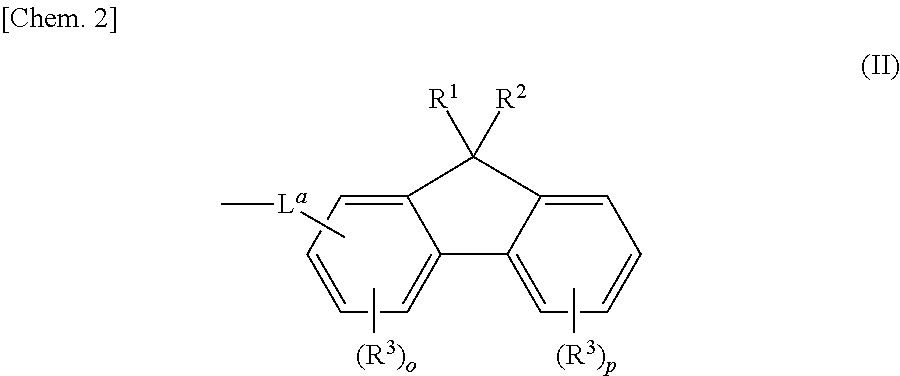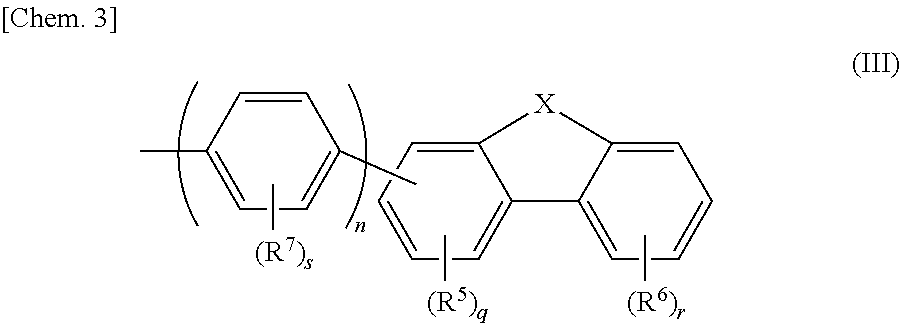Aromatic amine derivatives and organic electroluminescent elements using same
an organic electroluminescent element and amine technology, applied in the direction of organic chemistry, luminescent compositions, other domestic articles, etc., can solve the problems of increasing driving voltage, reducing luminous efficiency, and changing luminescent color, so as to improve the stability of a thin film, reduce the driving voltage of the organic el device, and high charge mobility
- Summary
- Abstract
- Description
- Claims
- Application Information
AI Technical Summary
Benefits of technology
Problems solved by technology
Method used
Image
Examples
synthesis example 1
Synthesis of Intermediate-1
[0183]In a stream of argon, 47 g of 4-bromobiphenyl, 23 g of iodine, 9.4 g of periodic acid dihydrate, 42 ml of water, 360 ml of acetic acid, and 11 ml of sulfuric acid were loaded into a 1,000-ml three-necked flask, and the mixture was stirred at 65° C. for 30 minutes and was then subjected to a reaction at 90° C. for 6 hours. The reactant was poured into ice water, followed by filtering. The resultant was washed with water, and then washed with methanol, whereby 67 g of a white powder were obtained.
[0184]Main peaks having ratios m / z of 358 and 360 were obtained with respect to C12H8BrI=359 by a field desorption mass spectrometry (hereinafter, referred to as FD-MS) analysis, so the powder was identified as the intermediate-1.
synthesis example 2
Synthesis of Intermediate-2
[0185]Under an argon atmosphere, 12.5 g of 2-bromofluorene, 0.7 g of benzyltriethylammonium chloride, 60 ml of dimethyl sulfoxide, 8.0 g of sodium hydroxide, and 17 g of methyl iodide were loaded into a 200-ml three-necked flask, and then the mixture was subjected to a reaction for 18 hours.
[0186]After the completion of the reaction, water and ethyl acetate were added to perform separation and extraction. After that, the resultant was concentrated, and then the resultant coarse product was purified by silica gel chromatography (hexane). Thus, 12.4 g of a yellow oily substance were obtained. The substance was identified as the intermediate-2 by FD-MS analysis.
synthesis example 3
Synthesis of Intermediate-3
[0187]A reaction was performed in the same manner as in Synthesis Example 1 except that 2-bromo-9,9-dimethylfluorene was used instead of 4-bromobiphenyl. As a result, 61 g of a white powder were obtained. The powder was identified as the intermediate-3 by FD-MS analysis.
PUM
 Login to View More
Login to View More Abstract
Description
Claims
Application Information
 Login to View More
Login to View More - R&D
- Intellectual Property
- Life Sciences
- Materials
- Tech Scout
- Unparalleled Data Quality
- Higher Quality Content
- 60% Fewer Hallucinations
Browse by: Latest US Patents, China's latest patents, Technical Efficacy Thesaurus, Application Domain, Technology Topic, Popular Technical Reports.
© 2025 PatSnap. All rights reserved.Legal|Privacy policy|Modern Slavery Act Transparency Statement|Sitemap|About US| Contact US: help@patsnap.com



